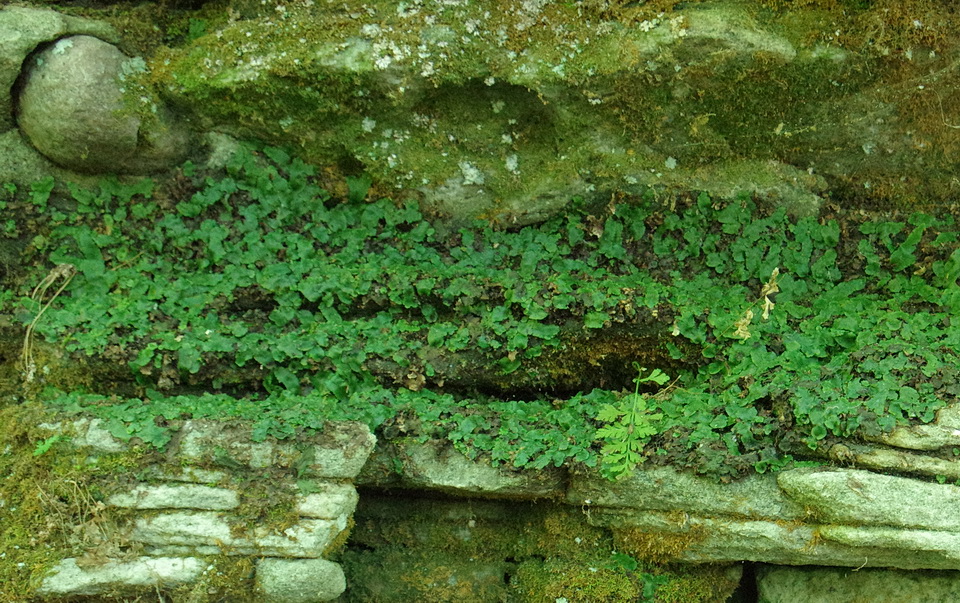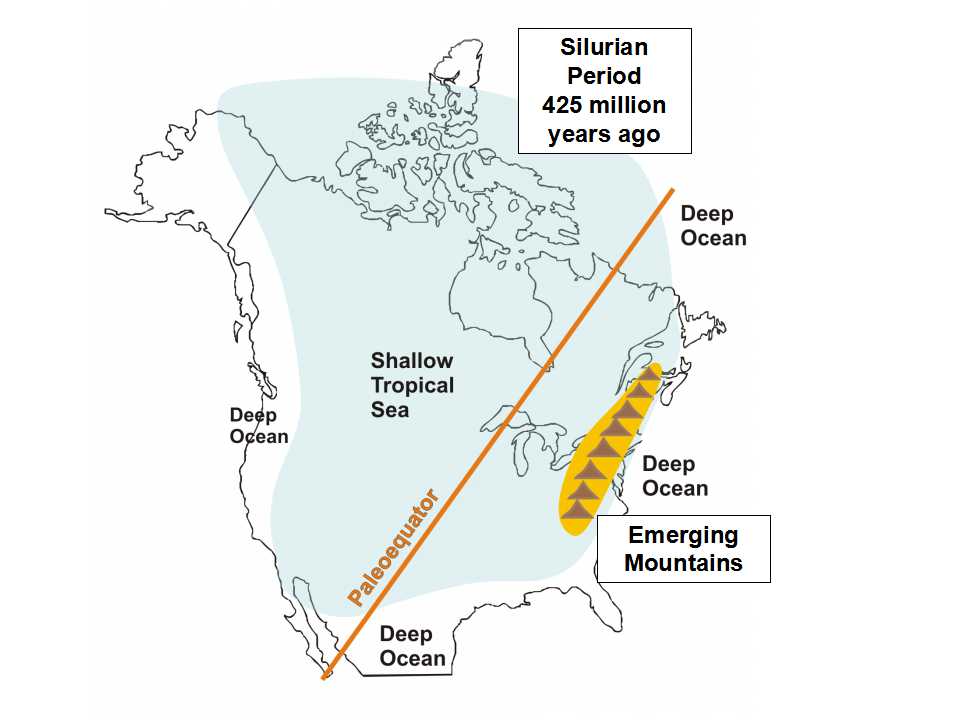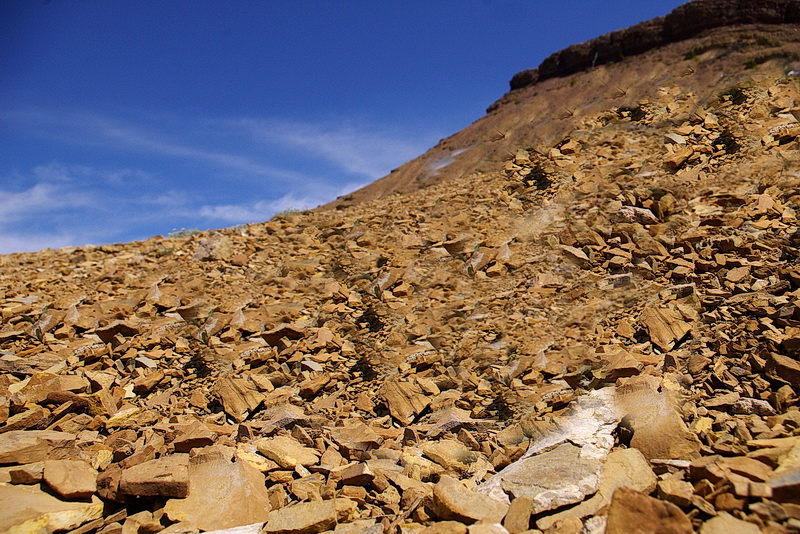The Geological Story of First Life On Land: Liverwort And Colonalization of Land, Charleston Lake Provincial Park
Liverwort pollen occur as fossils in rocks that are 472 million years old. Liverworts are among the first plants to have colonized the Earth's land. This thalloid liverwort (Lunularia cruciata) is growing on shady ledges of Cambrian-aged (about 510 million years old) sandstone and conglomerate, Nepean Formation, Potsdam Group, along the Hemlock Ridge Trail, Charleston Lake Provincial Park. Photo by Andy Fyon, Sept 28/16.
Let's Imagine: Ontario 500 Million Years Ago
Imagine that you are standing on the land about 500 million years ago! What would you see? What did the surface of the Earth look like then?
Ontario was quite a different place 500 million years ago. The length of the Earth day was 22 hours - about 2 hours shorter than today. The Sun was about 80% as bright as it is today. You would have been able to breathe because the atmosphere had evolved to the stage where atmospheric oxygen levels were getting close to levels of today.
The Earth's climate was probably warmer and more uniform than today. The average Earth's temperature may have been as much as 10 degrees C warmer than today.
Much of the surface Earth was covered by warm seas. There was no polar ice.
Most of Ontario and North America was covered by warm tropical and temperate seas and the equator ran across Ontario.
This cartoon shows the location of the equator and the extent of of a warm ocean that covered all of what we now call Ontario about 425 million years ago, during a time called the Silurian Period. You may be surprised to learn that a very long time ago, Ontario was located along the equator! The geological process called continental drift is responsible for Ontario's move from the tropical equatorial area to our present geographic location much further north. Image modified after Coniglio et al., 2006: Manitoulin Rocks!).
There was some land that was not covered by ocean. What did the surface of that land look like? The land was barren, likely dry and rocky. Locally, there may have been microbial soil crust. There was no vegetation as we know it today - no grass, no trees, no plants.
This photo shows what the land may have looked like 500 million years ago, during the Cambrian Period. There were no trees, no grasses, and no plants. It was a barren landscape. Photo by Andy Fyon, Table Mountain, Alberta, June 2006.
Life on Land: Ozone Was Key
Prior to this time in Earth's history, early life on Earth began and lived in the oceans. So, what changed to allow life to move from the ocean to colonize the land?
Two factors were important to allow colonization of the land: oxygen and ozone in the Earth's atmosphere. A special type of ocean bacteria, called blue-green algae, worked hard over the initial 4 billion years of Earth history to produce enough oxygen that the Earth's oceans became oxygenated and the atmosphere become breathable by about 600 to 500 million years ago. There was something else about the Earth's atmosphere that you could not see, but was critical to life on Earth. High in the atmosphere, ozone levels increased when oxygen appeared. By about 600 million years ago, there was enough ozone in the atmosphere to absorb the life-killing ultraviolet radiation that was released from our Sun.
Ozone was very important for in the evolution of life on Earth. Ozone allows life to exist as we know it today. Before ozone concentrations in the atmosphere had increased, all life on Earth existed in the oceans, protected from the life-killing ultraviolet radiation. Many see the appearance of oxygen in the ocean and atmosphere, and therefore, ozone in the upper levels of the atmosphere, as the critical step that enabled life to leave the protective cover of the ocean, or other protective strategy that remains a bit of a mystery, and begin to colonize the land.
First Land Plant 500 Million years Ago: Liverworts
The best estimate is that first land colonization occurred sometime between 500 million and 472 million years ago. The evidence for this land colonization comes from fossil liverwort pollen grains that have been found in 472 million year old rock. That rock formed on the surface of the Earth, not in the oceans. Geologists have a name for this time: the Cambrian Period (545 to 495 million years ago) and the Ordovician Period (495 to 443 million years ago).
The discovery of fossil liverwort pollen shows that land plants had evolved by 472 million years ago and begun to colonize the surface of the Earth. This evidence shows that liverworts were one of the first life forms to colonize the land and are likely the ancestors of many, or all, land plants.
An example of a thalloid liverwort, possibly Lunularia cruciata, growing on the damp, shady forest floor along a creek, Morris Island Conservation Area, June 10/16. Photo by Andy Fyon.
Liverwort Today:
Liverwort is a bryophyte - that is, it is a primitive, non-vascular plant. Mosses and hornworts, like liverworts, are also bryophyte plants.
Modern-day thalloid liverwort, possibly Lunularia cruciata, growing on ancient Precambrian rock of the Nepean Formation, estimated to be about 510 million years old. Location: Hemlock Ridge Trail, Charleston Lake Provincial Park, Sept 28/16. Photo by Andy Fyon.
Liverworts do not have roots. They attach themselves to the ground using a appendage known as rhizoid. Tree and flowering plant leaves have veins, called vascular tissue, that serve as a plumbing system to move water, nutrients and other materials from the roots to the top of the plant. This vascular plumbing system allows trees and plants to grow to a very large size. Liverworts do not have a vascular plumbing system, so they remain small in size. Tree and flowering plant leaves have window-like stomata that close when the leaf is threatened with hot dry weather. In contrast, liverworts do not have stomata. In hot dry conditions, liverwort plants shrivel and dry out. Liverworts depend on rain or ground seeps for fertilization. Liverworts reproduce from spores that are dispersed by wind and rain. The favourite modern-day habitat for liverwort is an area that is cool, moist, and shady. They are often pioneers on rocks, tree trunks, decaying logs, stumps, and soil by streams, ponds, footpaths, and roads.
In the photo above, the green plant is liverwort that is growing on conglomerate and sandstone of the Nepean Formation. This sandstone deposit is estimated to be 510 million years old, or Upper Cambrian in age. The modern habitat is moist, shady, and protected. Groundwater seeps provide required moisture.
In Ontario, the Nepean Formation rocks formed as land-based sand dunes, river deposits, and beach deposits on top of, and surrounding islands of, ancient 1 billion year-old Precambrian Shield rock. The modern liverwort in the photo above grows today on rock that formed in a likely habitat that was the niche of the Earth's first land colonizers, about 500 million years ago.
Summary: First Plant Life on Land
For the first 4 billion years of Earth history, life on Earth evolved in the protective cover of the oceans that filtered out the life-killing ultraviolet radiation from our Sun. By about 600 to 500 million years ago, bacteria had added oxygen to the atmosphere and the oceans. As a result of the elevated atmospheric oxygen, ozone concentrations in the upper levels of the atmosphere also increased. That ozone filtered out the life-killing ultraviolet radiation. That critical step allowed life, in the form of liverwort, to move out of the ocean to colonize the land. Liverwort was the first land plant on Earth.
Liverworts occur today around the Earth. So, the next time you find a liverwort living on the Ontario Beneath Our Feet, pause and reflect on what you are looking at - the land-based ancestor of all terrestrial plants! How cool is that!
Updates:
Update November 4/17: The Secret Lives of ancient land plants (Sciencedaily.com): Researchers have unraveled the genome of the common liverwort (Marchantia polymorpha) and gain insights about the evolution of this early land plant.
Some Sources of Information:
a) The Earth’s first breathable atmosphere, by By Shireen Gonzaga in EARTH , March 2011.
b) The Atmosphere: http://teachertech.rice.edu/Participants/louviere/history.html
c) Pulse of atmospheric oxygen during the late Cambrian; by Matthew R. Saltzmana, Seth A. Young, Lee R. Kump, Benjamin C. Gill, Timothy W. Lyons, and Bruce Runnegar, in February 21 edition of the Proceedings of the National Academy of Science.
d) Earth’s Early Atmosphere; Universe Today.
e) Geologic temperature record; Wikipedia;
f) The Cambrian Period: http://www.ucmp.berkeley.edu/cambrian/cambrian.php
g) Silurian Period Facts: Climate, Animals & Plants; By Mary Bagley, LiveScience Contributor.
g) Fossils of earliest land plants discovered in Argentina; BBC Earth News, October 12, 2010.
h) Plant Life: Liverworts: http://lifeofplant.blogspot.ca/2011/03/liverworts.html
i) Backyard Nature: Liverworts: http://www.backyardnature.net/liverwrt.htm ;
j) Video Journal #1: Expedition Overview--Early Land Plants [bryophyte - liverworts] of Chile
k) On the Origin of Plant Species. A macroscopic history (discussion of first terrestrial live including liverworts)
Andy Fyon, October 7, 2016; October 26, 2016; April 6/17; Nov 4/17; Dec 26/24





